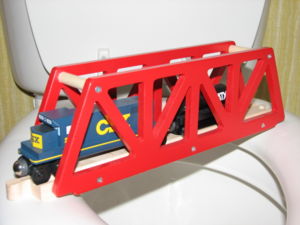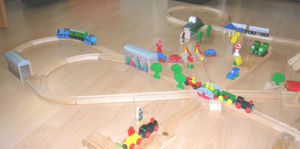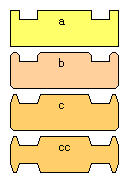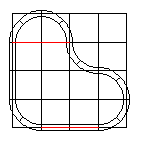Wooden toy train
Wooden toy trains are a system of small toy trains that run on wooden track, the track featuring grooves which serve to guide the wheels of rolling stock.
Traditionally, parts are made of hardwoods which resemble anthropomorphical, fictional, and prototypical railroad equipment. Early wooden trains connected to each other using metal hooks, these have since been mostly replaced by small magnets.
Most manufacturers have supplemented the wood with plastics, such as the use of plastic wheels mounted on metal axles. The majority of the rolling stock, track, fixed plant, and scenery accessories are still made of wood.
Contents
History
Skaneateles Handicrafters
In 1936 Marshal Larabee founded the Skaneateles Handicrafters, a toy company based wooden toy trains on wooden tracks. The gauge was very similar to that used by most companies today, and so the rolling stock is compatible in that respect. The connections for the track pieces though were of a different design than the jigsaw style "peg and hole" system known today. Trains were usually left unpainted and unstained, the parts being made of Maple.
Brio
Brio started introducing its wooden toy train system with wooden tracks in Europe in 1957. It may have been the first company to use the "peg and hole" system to connect the pieces in mass production that all companies use today. Brio may have been the first company to use beech wood for this product.
Eichhorn and Heros
There was a long tradition of wooden toy-making along the mountain forests surrounding Bohemia. Two famous places were Seiffen with their wooden figures and Christmas decorations and Blumenau with their building blocks and construction sets. Mass production techniques of polishing and coloring wooden toys had been established and perfected here. Some of the early sets already show train designs that have been later used for the wooden track trains. In 1949 Hermann Eichhorn of the Blumenau tradition and origin founded his company for wooden toys in the Bavarian town of Egglham and in 1961 started producing his version of the wooden track railway system. Heros the company of Hermann Rossberg of Lam in the Bavarian Fores] near to the border of Bohemia had some pull along Trains in the Blumenau tradition. He too started a line of wooden track trains using his pull along train designs in bright colors. Eichhorn claims to be the first company to have systematically used the so called "vario system" for the connectors. It did apply for a US-patent[1] for a "Battery powered toy train" in 1994.
Thomas the Tank Engine
"Thomas the Tank Engine" is a character invented by the Rev. W. Awdry in The Railway Series of children's books. The books were first published in the U.K. in 1945. In 1984 a television series called Thomas the Tank Engine and Friends was made adding to the popularity of the characters. It was first shown in the United States in 1989. John W. Lee founded the company "Learning Curve Toys" in 1993 with a wooden railway system called "Thomas & Friends" based on the Thomas the Tank Engine characters. This made the wooden toy trains even more popular than before. Learning Curve introduced some new designs for the track surface, such as the "Clickety Clack" rails patented 1995[2] and the newer tracks with a relief to supply better traction grip for battery powered trains patented in 2003.[3]
Electronics
Although the original push along trains made mostly of wood still resemble the core idea of this system toy and as of 2006 is the base of all the involved companies production lines, electronics have gained access to the wooden world. After introducing battery powered engines in the nineties, remote control has been added by 2002 and so called smart track has introduced plastic parts to the wooden track pieces. In 2006 Brio even introduced a theme resembling electronic networking with some electronic gadgets. Altogether this has led to some new track designs allowing better traction for the self powered trains or means of communication between the tracks and trains by some magnetic or electronic gadget.
The Track System
The Gauge
Described in the metric system the grooves appear to be 3 mm deep, 5 mm wide and have 20 mm between them. The tracks themselves are 40 mm wide and 12 mm high. To be kept on track the system can be reduced to a shallow groove 30 mm wide as in some road systems or small ramps that allow the vehicle to get on or of the track from the floor, or a middle section 20 mm wide and 3 mm high as in some beginners tracks or double track road systems. Most modern track systems have a somewhat sophisticated profile with varying degrees of slanted sides for the grooves or rounded edges. In the empirical system the tracks have been described with groves an eighth of an inch deep, a quarter of an inch wide and have three quarters of an inch between them. The tracks themselves are one and a half inches wide and half an inch high.[4]
Flipping Track pieces
Some track pieces such as curves and points have grooves on both sides so that they can be used from both sides. By flipping the piece around one can convert a left-hand curve or point to a right-handed one. This feature seems to be unique to the wooden track toy train systems. Another possibility is to have the two grooves for trains on the one side and the single wide groove for roads on the other side. Learning Curve made such tracks for their "Thomas the Tank Engine" theme.
The Vario System
When trying to document a layout with exact geometry one quickly notices that a lot of layouts one builds with real track do not work using a CAD system or some track layout program.[5] This is due to the so called "vario system" which allows some play when joining the tracks, so that with some wiggling around one can make layouts line up perfectly with no danger of derailing the trains that don't use the exact geometry of the pieces. This is achieved by making the pegs somewhat smaller than the holes. The round part of the hole sometimes is not an exact circle, but rather an ellipse allowing the tracks to connect with a small gap between them. Also the neck gap doesn't have a sharp edge at the end of the track but is carved round. This may have started as a production loss or to make it easier for small children to join the tracks. Some sources state that Eichhorn was the first to design the connections using this system.
Some Track and Layout geometry
Though not all manufacturers use the same system for their track piece designs some principle standards have evolved, as the geometry involved with track systems tends to pose the same problems to everyone. The first question may be how to divide the circle. The standard for wooden tracks is eight pieces. The next important length is the diameter of the circle made of a line along the center of the tracks. This length is useful for figures such as an eight with the crossing at right angles, a simple L-figure, a bulge to one side or a spectacles or Mickey Mouse head, to name the simplest.
A division in two gives a handy piece of straight track. For the figure eight one could use two straight pieces to go underneath and a use a bridge made to the same length to cross over the other straights. If one wants a crossing on the same level, the diameter can be divided by three and a crossing piece made with straights of that length. Of course one can also produce pieces of a quarter diameter length to put to the left and right of a central bridge piece that is half the diameter long. As one can see it turns out to be useful to determine the length of the straight tracks by dividing the diameter of the circle made by the curves. Brio uses the lengths of half, quarter and eighth as well as a third and sixth.
To solve the problems of the offset produced by points that branch out at the same angle producing parallel tracks, it is also useful to design such points and switches so that one of the short straights can compensate the offset. An easy way to design points is by tracing a long and a curved track to the same piece using the same connecting point as the origin. Such a merged piece can thus serve as a curve for one branch and a straight for the other while using the same dimensions as the other pieces.
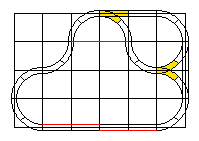
Road systems
Several approaches have been made over the time to add a road system to the railway tracks. The first and still most widely used level crossings use simple ramps that enable vehicles to cross the thick tracks from whatever undergrounds the tracks are placed on. The simplest way to add roads to this existing solution is to provide a layout printed on a paper or plastic sheet or even a carpet that uses the dimensions used by the wooden tracks. Some companies have made thin track pieces out of plastic or other materials that can be joined by some connecting system and have special crossover pieces to allow playing together with a wooden railway system. The next step seems to have been road track pieces of similar thickness as the railway tracks but using some other connecting design. Using the same "peg and hole" system as the railway tracks seems to have come later. The "Thomas the Tank Engine" theme from Learning Curve used track pieces that had the traditional railway design on ,one side and a new road design on the other. These roads had the same profile and measurements as the railway tracks, except that the part between the grooves was missing so that the road was a broad "groove" with sidings. The road vehicles and the railway rolling stock could be used interchangeable on both systems. Brio had introduced a track with wider grooves that was used for trains aimed at a younger age group. These used the same connection system as the other tracks and had the same distance between the grooves. This made it possible for the normal trains to run on the wider tracks. When these wide grooves have the same width as the "Thomas the Tank Engine" road pieces they can be used as a two way road. Other companies have since adopted this system.
The rolling stock and accessories
Design origins and developments
The early sets such as of Skaneateles, Eichhorn and Brio seem all to have used rather simple and abstract designs. The pieces where not painted, so that trains and tracks had the same surface. The normal early trains had engines and wagons carved from a single piece of wood each and being connected with hooks and eyes. Painted sets may have become common in the early seventies as well as the use of magnets as connectors. Engines carved from a single block were commonly painted black in Europe with bright red funnels and wheels. The early trains made with construction sets and larger pull along trains may have influenced the early train designs, that where built of several wood pieces. Normally each wood piece had an individual single color, thus the resulting engine, for example, could sport six different colors. One each for the base plate, the cylindrical boiler, the drivers cabin, the cabin roof, the funnels and the wheels. Sets with painted patterns seem to have become more popular in the late eighties and nineties. This may have been due to the success of the "Thomas the Tank Engine" series and the wish for more realistic real world designs.
As of 2007 there seem to be several directions the design is taking:
- One group seems to emphasize the material wood. Some are simple "back to the roots" designs, while others take a more artistic approach, searching for new ways to abstract the train theme.
- Another group tries to stay true to the material wood but use more realistic designs with series based on famous real life trains.
- A modern view is to use more and more plastic and building battery powered and remote controlled objects, with electronic devices gaining ground.
- Specialty trains for specific things like alphabet trains, name trains and decoration sets like birthday trains with candles.
Bridges and Tunnels
Early Skaneateles sets had rectangular supports that raised the track gradually. Due to the different connection system Skaneateles used at that time, tracks could be easily bent upwards at the connection point. The two-piece bridge with massive ramps has been common since the sixties. Provided with supports, this bridge could be easily elongated using normal straights. More modern bridge designs have used large amounts of plastic since the eighties, reducing the amount of wood needed and thus producing lighter and cheaper designs.
Buildings
Early buildings had windows and doors made by drawing lines in a single color on simple rectangular blocks. Sometimes they had slanted roofs made with another piece of wood, painted another color, stacked on top. A common early station design consisted of a simple platform with a roof on two or three supports along the longer axis. Later buildings have printed multicolor patterns. There have always been building sets that where similar to the popular wooden building blocks allowing lots of individual designs.
Licensing and merchandise themes
- Sesame Street - (Skaneateles Handicrafts/Playskool 70s?)
- Thomas the Tank Engine - (Learning Curve 1993)
- Jim Knopf/Button - (Euro-Play pre 2000?(Tesco?), Brio from 2000 on)
- Bob the Builder - (Brio 2001)
- Benjamin Blümchen - (Eichhorn 2001)
- Curious George - (Brio 2002)
- Busytown - (Brio 2002)
- Babar the Elephant - (Brio,France)
- The Little Engine that Could - (Maxim, Whittle Shortline as of 2006)
- Winnie the Pooh - (Eichhorn 2006)
- The Polar Express - (Brio 2006)
The brands
Europe
- Brio, Company founded 1884 in Osby in southern Sweden. Produces Wooden Railways since 1957.
- Eichhorn, Company founded 1949 in Egglham in southern Germany. Produces Wooden Railways since 1961.
- Heros, Company founded by Herrman Rossberg in Lam in southern Germany.
- Micki Leksaker of Sweden, may be the manufacturer of the "Lillabo" wooden train series from Ikea.
- Hartung, Berlin Germany. May sample some sets with products from different maufacturers.
- Babalu, sold only by Karstadt, Germany, produced in China. Some items may be of the same origin as for Maxim and Imaginarium.
- Bino, sells Mentari Toys sets
- Spielmaus, Home brand of Vedes toy shops, Germany
- "Hornby", toy train line by Hornby Railways of England.
- Bentatec, has a small line of trains.
- Imaginarium / Universe of Imagination, brand sold by ToysRus. Some items may be of the same origin as for Maxim and Babalu.
- "Tesco", sold at the Tesco stores may be related to Euro-Play
North America
- Skaneateles Handicrafts - T.C.Timber - Habermaas, Company founded 1936 by Marshall Larabee in Skaneateles NY in the northeast of the USA. Claims to have invented the Wooden Track Gauge.
- Learning Curve, Thomas & friends, Company founded 1993 by John W. Lee in the USA. Produces trains based on the Thomas the tank characters. Since 2003 owned by RC2.
- Maple Landmark, Company founded 1979 by Mike Rainville in Vermont USA. Produces Trains for the wooden track system since 1993.
- Whittle Shortline, Company founded 1997 by Mike Whitworth in the USA. www.woodentrain.com
- Lionel - Produce a special line of realistic trains together with Maxim since 2006
- Suretrack, produces securing trackclips.
- Nilo, produces flexible tracks.
- Maxim, Making toys since 1962. Has a joint venture project with Lionel since late 2005, introducing a new line of realistic trains under the brand name of Lionel by 2006.
Asia
- China - produces for many companies (Remus, Europlay,Babalu, Maxim)
- Plantoys, Thailand. Produces a street system that is compatible with the wooden train tracks.
- Mentari Toys, production in Indonesia. Products may have been sold under the brands elile, FunToys, Toytopia and Bino.
- The Toy Company (sold in Germany under the brand name Beeboo, also sells Mentari sets under own brand)
See also
External links
The fans
- Self-made toys
- Track, buildings and rolling stock at "Jigs and notes for making wooden train tracks" by Brian K. Donnelly.
- Trains at Hoogerland National Railways by Todd Hoogerland.
- virtual toys
- "BRIO® Wooden Railway Raytracing" by John Mechalas using AutoCad.
- Raily for Windows - Track layout program, with description of Brio tracks.
- Trackdraw - Track layout program to build layouts for Lego trains, Woodtrack Trains, Slotcars and other things.
- Collectors
- The Wooden Railway Page - Australian enthusiast's personal website, containing photos of his large collection.
Sources
- Links
- Doug Atkinson at Toy wooden Railroadsand old version here. With a nice history page here.
- Manufacture homepages
- Museums
- Nürnberg Spielzeug Museum (Nuremberg Toy Museum, Germany)
- Literature
- Brio catalogs 1984, 2001-2006
- Eichhorn catalogs 2001, 2004-6
